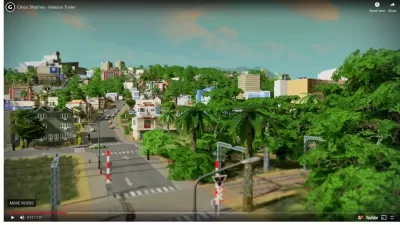The video game has inspired many people to pursue careers in planning. But, the newest version is also trying to better align the simulations with what planners face in the real world.

Jessica Roy writes about the history and influence of SimCity, the urban planning simulation game first released in 1989:
For many urban and transit planners, architects, government officials and activists, "SimCity" was their first taste of running a city. It was the first time they realized that neighborhoods, towns and cities were things that were planned, and that it was someone's job to decide where streets, schools, bus stops and stores were supposed to go.
While SimCity lead many planners into the field, the game has been criticized for creating worlds that do not reflect reality. The cities do not have bike lanes or mixed-use developments and, in the past, did not have parking. In addition, the options and solutions are oversimplified, say critics. "To lower crime rates, build police stations. If people complain about traffic, build more roads. If you need space to build a freeway or a stadium, raze working-class neighborhoods," says Roy.
The most recent iteration, an app called "SimCity: BuildIt" released in 2014, tries to address some of the limitations of earlier versions. The architecture and topography are more diverse, and some of the buildings include visible parking. "You can play a 'Green City' map in which residents have urban gardens and there's less pollution. Solar power is now an option," notes Roy.
FULL STORY: From video game to day job: How ‘SimCity’ inspired a generation of city planners

Planetizen Federal Action Tracker
A weekly monitor of how Trump’s orders and actions are impacting planners and planning in America.

Restaurant Patios Were a Pandemic Win — Why Were They so Hard to Keep?
Social distancing requirements and changes in travel patterns prompted cities to pilot new uses for street and sidewalk space. Then it got complicated.

Map: Where Senate Republicans Want to Sell Your Public Lands
For public land advocates, the Senate Republicans’ proposal to sell millions of acres of public land in the West is “the biggest fight of their careers.”

Maui's Vacation Rental Debate Turns Ugly
Verbal attacks, misinformation campaigns and fistfights plague a high-stakes debate to convert thousands of vacation rentals into long-term housing.

San Francisco Suspends Traffic Calming Amidst Record Deaths
Citing “a challenging fiscal landscape,” the city will cease the program on the heels of 42 traffic deaths, including 24 pedestrians.

California Homeless Arrests, Citations Spike After Ruling
An investigation reveals that anti-homeless actions increased up to 500% after Grants Pass v. Johnson — even in cities claiming no policy change.
Urban Design for Planners 1: Software Tools
This six-course series explores essential urban design concepts using open source software and equips planners with the tools they need to participate fully in the urban design process.
Planning for Universal Design
Learn the tools for implementing Universal Design in planning regulations.
Heyer Gruel & Associates PA
JM Goldson LLC
Custer County Colorado
City of Camden Redevelopment Agency
City of Astoria
Transportation Research & Education Center (TREC) at Portland State University
Camden Redevelopment Agency
City of Claremont
Municipality of Princeton (NJ)





























